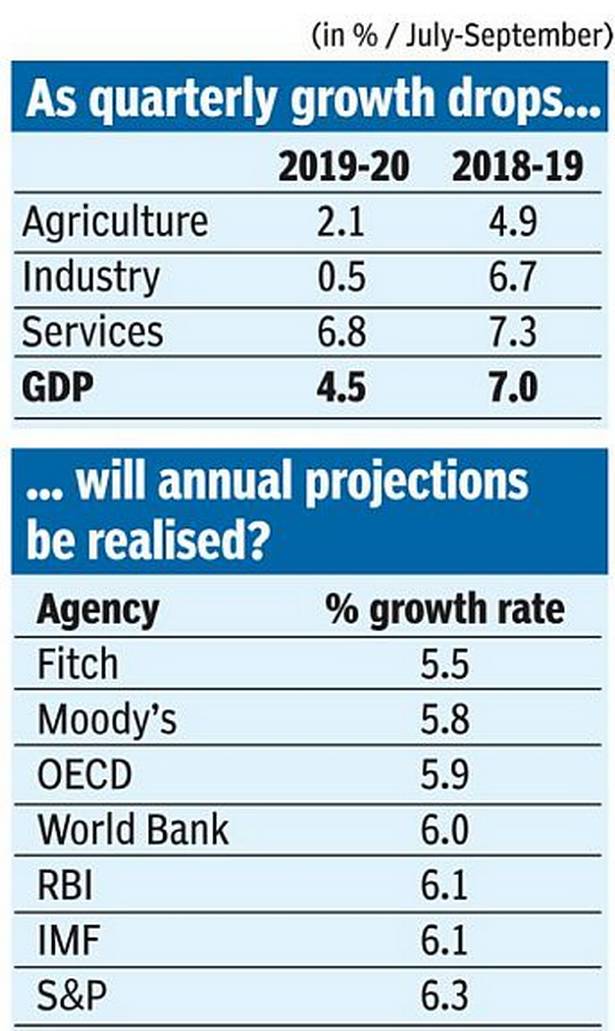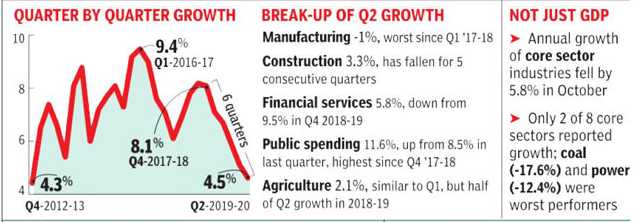Indian Economy
GDP Growth
- 30 Nov 2019
- 5 min read
Why in News
As per the data released by the National Statistical Office, India’s Gross Domestic Product (GDP) growth slipped to a 26-quarter low of 4.5% in the second quarter (Q2 i.e. July-September) of the financial year 2019-20.
- The growth is the lowest in six years and three months with the previous low recorded at 4.3% during the January - March 2013.
- In terms of quarterly growth, India has lost the tag of the fastest growing economy to China which posted a growth of 6% in the September quarter.
- Reasons for fall in growth include contraction in manufacturing, weak investment, and lower consumption demand.
- The global economy is also facing a slowdown and this has hurt demand for India's exports, which have slumped in recent months.
Key Points
- Growth in Gross Value Added (GVA) dipped to 4.3% in Q2 of 2019-20 from 6.9% in Q2 of 2018-2019.
- Manufacturing Sector Growth contracted 1% as against 6.9% growth last year during the same quarter.
- Agriculture, forestry and fishing sector recorded a growth rate of 2.1% as against 4.9% last year.
- The ‘Financial, Real Estate & Professional Services’ category saw growth slow to 5.8% in Q2 of 2019-20, compared with 7% in Q2 of the previous year.
- Private final consumption expenditure, the closest proxy in the data to a measure of consumption demand, grew 5.06% in Q2 of 2019-20 as against the growth of 9.79% in Q2 of the previous year.
- Gross fixed capital formation, which is a measure of the level of investment in the country by both the government and the private sector, grew only 1.02% in Q2 of 2019-20 as against the growth of 11.8% in Q2 of last year.
Recent Signs of Economic Slowdown
- The collapse of IL&FS in September 2018.
- The financial sector is on the brink as indicated by huge number of Non-Performing Assets (NPAs).
- Though the Reserve Bank of India has cut the key policy rates (like Repo rate), the banks have not transferred the same to the final consumers. Thus, the two critical needs of the industry i.e. cost of credit and availability of credit, have not been met fully.
- The cumulative cut of 135 basis points by the RBI over the last nine months has translated into a meager 29 basis points (just over a fifth), with banks still retaining a huge spread.
- Cost of credit continues to remain high for most companies and the worst affected are small and medium enterprises.
Way Forward
- The government should give a high priority to implementing measures to bolster manufacturing output and kick-start an upturn in the investment cycle.
- Accelerated spending by the government is another way out but this action would be opposite to the government’s fiscal deficit target of 3.3% of GDP.
Note
- Gross Value Added (GVA) provides for value of the amount of goods and services that have been produced in a country, minus the cost of all inputs and raw materials that are directly attributable to that production. It is used to measure the output or contribution of a particular sector.
- Gross Domestic Product (GDP) is the single standard indicator used across the globe to indicate the health of a nation's economy. It is the sum of private consumption, gross investment in the economy, government investment, government spending and net foreign trade (difference between exports and imports).





